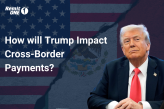Africa Remittances: Traversing the New Frontier | IPR Global 2023 January 29, 2024

This insightful session will explore the evolving landscape of remittances in Africa, with a key focus on the transformative impact of mobile money services and e-wallets. Our panel of experts will delve into topics like the role of innovative technologies, financial inclusion, regulatory challenges, and the potential to reduce costs and promote economic development through remittances.
Discover how these digital financial tools are reshaping financial ecosystems, empowering underserved communities, and fostering cross-border economic integration across the African continent.
Moderator
- Priscilla D´Oliveira Friedman, COO, CrossTech
Panellists:
- Temiloluwa Adesina, Senior Product Manager, Flutterwave
- Ababacar Seck, Managing Director, Africa, RemitONE & IPR
- George Boateng, Chief Operations Manager, Unity Link Financial Services Limited
- Reynell Badoe, Head, Everyday Banking, Stanbic Bank Ghana LTD
What is the current landscape of remittances in Africa, and how has it evolved over the past decade?
Across the continent, every country heavily relies on inbound transactions, creating a diverse landscape characterised by various players, services, business models, and remittance types, including traditional, digital, and informal methods. Despite the challenges posed by the COVID-19 pandemic, the remittance market in Africa has proven to be remarkably dynamic and resilient, defying expectations of a decline in transactions. Comparing the present situation to the early 2000s, Ababacar highlighted the transformation from a market restricted by exclusive contracts favouring big players in international transactions to a more open and inclusive space that allows for domestic, regional, and international remittances. In the past, high prices were a significant barrier, but the advent of digital remittances has started to address this issue, although cash remains important due to cultural and behavioural factors.
The region’s people embrace digital tools but still value the human element. For example, using digital wallets for making in-person purchases keeping the face-to-face experience intact. It’s a reminder that, even in our tech-driven world, the human connection remains a crucial part of how Africans handle their finances.
There has been growth in various sectors, such as mobile money, payments, sending goods, and B2B remittances, indicating the expanding horizons of remittance services. Furthermore, the informal market, once overlooked, is now recognised as a major untapped opportunity in the evolving landscape of remittances in Africa.
George recalls how in the past there was a heavy reliance on fax for transactions, which could take up to a week, whilst the shift to bank deposits seemed promising for quicker transactions, the uptake was low due to financial exclusion. The prevalence of cash transactions in Africa posed challenges for cash pickup in banks, requiring identification. However, the digital revolution, with its elimination of such barriers, has unlocked the potential. The increasing role of Mobile Network Operators (MNOs), expanding rapidly across Africa, is a key driver of this growth, making the remittance landscape more accessible and promising for the future.
Reynell delves into the changing dynamics from a banking perspective. Historically, banks in Africa primarily focused on settlements, with the actual business of money transfers being led by Money Transfer Operators (MTOs) and Payment Service Providers (PSPs). Remittances, play a crucial role in contributing significantly to the GDP of African countries, with figures ranging from 5-6% in countries like Ghana and Nigeria, and up to 10% in other regions. This underscores the economic importance of remittances in the African context.
The regulatory environment in Africa presents a hurdle, slowing down the pace of innovation for banks. Unlike MTOs, many banks in Africa still operate in person, leading to higher operational costs. This insight showcases the need for adaptation and innovation within the banking sector to keep pace with the evolving remittance landscape in Africa. Despite these challenges, Reynells perspective highlights the immense significance of remittances for African economies and the imperative need for banks to navigate regulatory complexities to actively participate in the changing dynamics of the remittance market in the continent.
What should companies be thinking about when entering this market?
It’s crucial to have a well-thought-out strategy when venturing into the African remittance market. Licensing requirements, play a pivotal role in determining the speed of market entry. Partnerships are another key factor that can significantly accelerate the entry process, emphasising the collaborative nature of the industry.
You can easily tap into reliable partners to fast-track your entry into the market through RemitONE Connections to secure you with an instant business community that would take months and years to build yourselves within the Africa region. This also means you must have flexible technology with strong API integration capabilities to connect, RemitONE’s Money Transfer Platform is both modular and scalable. For more information get in touch with us at sales@remitone.com.
Temi suggests, a targeted strategy focused on specific regions is more effective rather than adopting a broad approach. For instance, in francophone regions of Africa where french is widely spoken as a second language, similar regulations and cultures prevail. By tailoring strategies to these specific regions with shared characteristics, one can enhance the effectiveness of market penetration.
George reassures that entering the market shouldn’t be daunting as specialists are available in every country to help guide you through the loops. However, a thorough understanding of the local customer dynamics, including their behaviour, attitudes, and cultural nuances is essential. He advocates for a more strategic approach that involves aligning with the demographic profiles of potential customers that resonate with the services your company offers. This perspective underscores the importance of cultural sensitivity, customer-centric strategies, and long-term relationship building as key considerations for companies seeking to successfully enter and navigate the African remittance market.
What innovative technologies and platforms are reshaping the way remittances are sent and received in Africa, and how are they increasing financial inclusion?
Mobile money has significantly altered the dynamics of remittance transactions with the help of the widespread ownership of mobile devices, coupled with increased telecommunications access, which has catalyzed a notable surge in remittances across the continent. Partnerships between remittance providers and telecommunications companies like Safaricom, have also played a pivotal role. This collaborative approach has proven instrumental in fostering innovation within the industry, creating a synergistic environment where different players work together to enhance services and accessibility.
Furthermore, the adoption of stablecoins, with the involvement of companies like Stellar and Ripple, is an emerging trend. These digital assets provide stability in value and are being utilised by companies to facilitate remittance transactions, offering an alternative to traditional currency-based transfers.
Interoperability, between mobile wallets, bank accounts, and cash through partnerships, is another critical aspect of the evolving remittance landscape in Africa. The seamless connectivity between various financial instruments and channels ensures a more inclusive and user-friendly experience for individuals sending and receiving remittances.
What challenges do African diaspora communities face when sending remittances, and how can these obstacles be addressed to improve the flow of funds?
High costs associated with remittances into Africa continue to persist, irrespective of the sending country, attributable to both financial and regulatory obstacles. Despite the advent of mobile money, Reynell believes certain African countries still heavily rely on physical locations such as banks or MTOs, posing difficulties for beneficiaries in accessing funds.
Additional challenges faced by the underbanked, particularly in rural areas and villages, where limited access to banks poses a significant barrier. Foreign exchange (FX) fluctuations were identified as another obstacle, leading to reduced amounts being received by the recipients. In addition, regulatory challenges also extend to the senders, particularly undocumented migrants who wish to send funds. The need for proof of address or source of funds presents a barrier, hindering their ability to send remittances until these documents are provided. To mitigate this challenge, George proposes that an alternative solution would involve embracing informal money transfer methods as well as the increasing interoperability between MNOs which will provide new opportunities for more efficient and cost-effective money transfers.
Ababacar further observes that while Africans can travel between countries with just their ID, the requirement for a passport when sending money presents a misunderstanding and inconsistency that act as barriers to entry for remittances from the diaspora. This discrepancy in identification processes poses a challenge, adding an unnecessary layer of complexity for individuals attempting to send funds.
He further points out the lack of interoperability across the continent. The absence of a unified system restricts some diaspora communities from utilising MNOs as a viable option for remittance transactions. This limitation not only hinders the accessibility of services but also contributes to the overall challenge of navigating the remittance landscape.
Also, within many MNOs, there isn’t an available option to transact money in different currencies. This lack of flexibility in currency options adds another layer of complication for the diaspora communities attempting to send funds across borders.
To tackle these challenges, improving identification processes by harmonising them with the adaptable regulations in Africa may help alleviate inconsistencies in requirements. Furthermore, fostering interoperability across the continent would amplify the accessibility of remittance services for diaspora communities. Urging MNOs to offer transaction options in various currencies would significantly ease the flow of funds, catering to the diverse needs of the African diaspora.
What innovations are emerging within the mobile money ecosystem that have the potential to further enhance the convenience and efficiency of remittance transactions?
Mobile money services have notably increased accessibility by introducing digital wallets accessible through mobile phones. These mobile wallets have evolved beyond simple remittance tools and can now function similarly to bank accounts, offering users the ability to engage in activities such as loans, savings, bill payments, and more through dedicated mobile apps.
The widespread adoption of mobile wallets has spurred further innovation, with the integration of technologies like artificial intelligence (AI) to assess credit scores. This, in turn, enables the provision of loans and overdrafts based on users’ spending patterns, showcasing a holistic approach to financial services within the mobile money ecosystem.
George highlighted the cultural integration of mobile wallets in African daily life, noting that some individuals receive their salaries exclusively through mobile wallets. This trend has led to mobile wallets becoming integral to people’s lives, so much so that even transport providers can be paid using mobile money. The efficiency and convenience offered by mobile wallets have positioned them as more than just a substitute for traditional banking; they have become the preferred choice for many. Euromonitor International found in the sub-Saharan African region, there were over 600 million registered mobile money accounts, facilitating transactions exceeding USD 600 billion in 2022, with it expected to grow even more in the coming years, especially with the help of central banks reducing barriers to entry.
Moreover, George speculated on the future trajectory, foreseeing a potential end to the dominance of cash in the coming years. However, he acknowledged that this transformation depends on continued investments in the economy and the infrastructure required for the digital revolution to take root.
Priscilla added to this narrative by drawing parallels with Brazil, where digital payments, exemplified by Pix payments, have also been gaining prominence. These digital payment methods contribute significantly to driving economic growth, simplifying transactions, and mirroring the trend observed in the African mobile money ecosystem.
What next?
At RemitONE, our commitment is to provide you with cutting-edge technology, compliance solutions, and expert guidance to navigate the ever-evolving landscape of remittances. Whether you’re just starting out or looking to scale your business, we’ve got you covered.
Want to see how RemitONE can elevate your business? Book a free consultation with our experts today!
Related Posts
-

Power Up Your Platform: The Top RemitONE Features Driving Our Clients’ Success
What if the growth you’re chasing is already built into your system? If you’re using the RemitONE Money Transfer Platform,…
July 9, 2025 -

Trump’s Threats to Cross-Border Payments: What It Means for Your Money Service Business
Donald Trump’s return to office has reignited policy debates, with ripple effects already reaching the cross-border payments space. From remittance…
July 9, 2025 -

New White-Label Online Platform: Redesigned to Scale Customer Loyalty and Growth
Add powerful money transfer capabilities to your website — without the complexity. Our new Online Remittance Manager (ORM) is a…
May 22, 2025 -

How to Build a Leaner, Smarter Money Service Business in 2025
In an era of rapid regulatory change, rising customer expectations, and digital disruption, how can money service businesses (MSBs)—companies that…
May 22, 2025 -

Trump’s Threats to Cross-Border Payments: What It Means for Your Business
It’s been a short while since Trump stormed back into office, and he’s already shaken things up with his hard-hitting…
May 22, 2025 -

RemitONE Webinar: Future-Proof Your Money Service Business
Future-Proof Your Money Service Business: Tech-Driven Solutions to Cut Costs, Boost Transactions, and Drive Growth, Tuesday 8th April at…
May 22, 2025